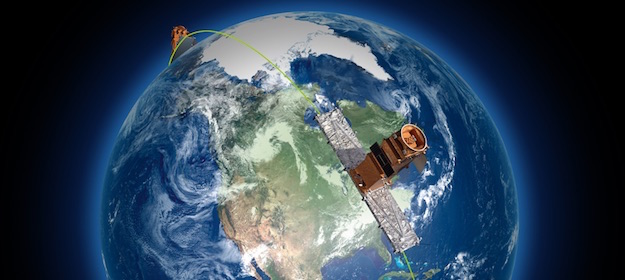
RADARSAT Constellation satellites set to launch
By Sidhartha Banerjee
General AerospaceCanadian Earth-observation satellites poised to monitor ecosystems and the Arctic following launch next week.

Following their launch on June 11, the three RCM satellites will be evenly spaced on the same orbital plane at an altitude of 600 km. (Photo credit: CSA)
Officials at the agency offered an overview Tuesday of the $1.2-billion government-owned project to replace the RADARSAT-2 satellite, which has been in orbit since 2007.
The three identical satellites, which will work together to locate ships, monitor ecosystems and keep tabs on the Arctic among other tasks, will be launched into orbit from Vandenberg Air Force Base in California aboard a SpaceX Falcon 9 rocket on June 11.
Once operational later this year, the evenly spaced satellites will orbit Earth every 96 minutes at an altitude of about 600 kilometres. They are expected to generate 250,000 images per year – 50 times more than the first generation RADARSAT satellite.
Engineer Magdalena Wierus told a briefing the new system will provide a major upgrade over its older counterpart, able to revisit an exact point on Earth every four days versus every 24 days for RADARSAT-2.
“We can use these images to measure changes, in ground movement for example, which can help us understand what is happening on the Earth better,” Wierus said.
The maritime surveillance feature will allow the satellites – with or without radar – to pinpoint ships that might be in trouble or those vessels that don’t want to be found, she added.
And the satellites will also play a key role in monitoring climate change – particularly the largely uninhabited North that doesn’t have much monitoring infrastructure.
“This is where there’s the most impact on climate change, especially on the permafrost,” said Steve Iris, the mission manager. “With the Constellation mission, we’ll be able to monitor every day and monitor subtle changes like ground changes due to permafrost melting – every four days – which is big advantage compared to what we have right now.”
The satellite trio will have the capacity to capture an image of a given location on about 90 per cent of Earth, but they will be primarily used to keep tabs on Canadian territory for the federal government.
The details haven’t been formalized, but the plan is also to make the data available to third parties in industry and academia. However, it won’t be sold commercially, the agency said.
It will take about five days to deploy all three satellites, after which a commissioning period of between three and six months will commence to make sure they’re properly functioning. Normal operations would begin after that.
There are contingency plans in place to deal with any potential problems.
The billion-dollar price tag – up from an original estimate of $600 million when the project was announced more than a decade ago – includes the design phase, building, testing, launch and operational costs.
MDA Inc. is the prime contractor for Constellation, constructing the satellites at its facilities on the western tip of the island of Montreal.
The company also privately owns RADARSAT-2, and Iris said it will be up to them to decide what to do with it. It was designed to last seven years, but is still operating.
“For now, the system is good shape, there’s no deficiency,” Iris said.
The new satellites will be operated from a control centre at the Canadian Space Agency just south of Montreal, with a back-up control facility in Ottawa.
It remains to be seen whether Constellation can provide similar longevity. Wierus said its life span will depend on several factors, including keeping the three in a tight corridor and their ability to dodge space debris.
“Right now, we’re setting up for seven years and if it goes longer, we’ll be very, very happy just as we were with RADARSAT-1 and RADARSAT-2,” she said.
https://mdacorporation.com
